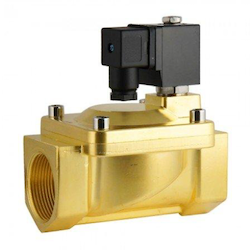
2/2-way solenoid valve
Solenoid valves are crucial components that offer precise and efficient regulation of fluids like water, gas, and air. These versatile devices find applications in various industries, including manufacturing, automotive, medicine, and everyday household appliances. Solenoid valves play a significant role in automating processes, enhancing safety, and improving overall system performance. This article explores solenoid valves, their features, and their types.
What is a solenoid valve?
A solenoid valve is an electromechanical device that operates as a controlled switch for fluid flow. It consists of a coil, often referred to as a solenoid, which generates a magnetic field when energized. This magnetic field acts upon a plunger or a movable core inside the valve, causing it to shift position and either open or close it. When the valve is open, the fluid can flow through the passage; when it’s closed, the flow is blocked.
Features
- Solenoid valves are specifically engineered to handle clean liquids and gases, ensuring optimal performance with these fluids.
- Their precise flow control capabilities make them well-suited for sensitive processes in medical devices and manufacturing, where accurate regulation of fluids or gases is essential.
- One of the key advantages of solenoid valves is their fast response time, enabling quick opening and closing actions. This characteristic is critical for safety applications, allowing for swift reactions to potential hazards.
- Solenoid valves offer a long service life, reducing the need for frequent maintenance and ensuring reliable performance even in demanding usage scenarios.
- The versatility of solenoid valves makes them applicable in a wide range of industries, including water treatment, automotive, and food processing, where their precise control and reliable operation are highly valued.
Working
When an electric current is applied to the coil, it creates a magnetic field that moves the plunger or core. Depending on the valve type and configuration, this movement either opens or closes the valve. The speed and precision of the valve’s operation make it suitable for various control applications, providing an efficient means of regulating fluid flow.
Solenoid valve types
Solenoid valves are classified based on their circuit function, configuration, and mode of operation.
Based on the mode of operation
Solenoid valves can be classified as normally closed (NC) or normally open (NO) based on their default state when not energized. In normally closed valves, the flow is blocked when the solenoid is de-energized, and when it’s energized, the valve opens to allow fluid flow. In normally open valves, the flow is allowed by default when the solenoid is de-energized, and it closes to stop the flow when energized.
Based on configuration
- Direct-acting solenoid Valve: In a direct-acting solenoid valve, the solenoid directly controls the movement of the plunger. When the solenoid is energized, it lifts the plunger, allowing fluid to flow through the valve. These valves are ideal for low-pressure applications and are known for their simplicity and reliability.
- Pilot-operated solenoid valve: Pilot-operated solenoid valves use a two-step process for opening and closing the main valve. When the solenoid is energized, it allows a small amount of fluid to flow, which in turn exerts pressure on a diaphragm or piston, leading to the opening of the main valve. These valves are suitable for high-pressure applications and require less power to operate.
Based on the circuit function
- Two-way solenoid valve: The two-way solenoid valve is the most common type and consists of two ports: an inlet and an outlet. When the solenoid is energized, the plunger or core is pulled, allowing fluid to flow from the inlet to the outlet. Conversely, when the solenoid is de-energized, a spring or other mechanism pushes the plunger back, closing the valve and stopping the flow. Two-way solenoid valves are used in on/off applications and are found in various household appliances like washing machines and dishwashers.
- Three-way solenoid valve: A three-way solenoid valve has three ports: one inlet and two outlets. When energized, the valve directs fluid from the inlet to one of the outlets, and when de-energized, it redirects the flow to the other outlet. This valve type is commonly used in applications where fluid must be diverted between two paths, such as in pneumatic systems or certain medical devices.
- Four-way solenoid valve: As the name suggests, the four-way solenoid valve has four ports: two inlets and two outlets. It is commonly used in applications where the flow needs to be switched between two separate paths, and it allows for bi-directional flow control. Four-way solenoid valves are often employed in hydraulic and pneumatic systems.
Conclusion
Solenoid valves are indispensable devices in fluid control systems, offering precise and rapid control over fluid flow. With their diverse types and configurations, they cater to a wide range of applications in different industries. From household appliances to complex industrial processes, solenoid valves continue to play a critical role in automating and optimizing fluid control. Understanding the different types and how they work enables engineers and designers to select the most appropriate solenoid valve for their specific applications, ensuring efficient and reliable operation.




Join the conversation: